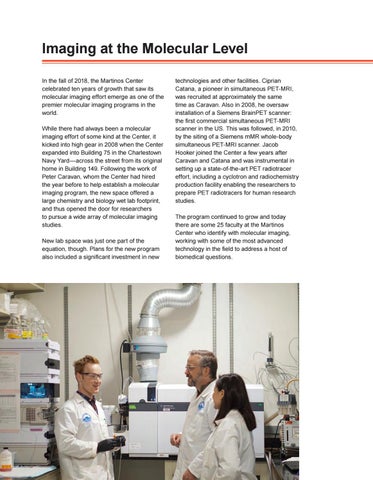Imaging at the Molecular Level In the fall of 2018, the Martinos Center celebrated ten years of growth that saw its molecular imaging effort emerge as one of the premier molecular imaging programs in the world. While there had always been a molecular imaging effort of some kind at the Center, it kicked into high gear in 2008 when the Center expanded into Building 75 in the Charlestown Navy Yard—across the street from its original home in Building 149. Following the work of Peter Caravan, whom the Center had hired the year before to help establish a molecular imaging program, the new space offered a large chemistry and biology wet lab footprint, and thus opened the door for researchers to pursue a wide array of molecular imaging studies. New lab space was just one part of the equation, though. Plans for the new program also included a significant investment in new
142
technologies and other facilities. Ciprian Catana, a pioneer in simultaneous PET-MRI, was recruited at approximately the same time as Caravan. Also in 2008, he oversaw installation of a Siemens BrainPET scanner: the first commercial simultaneous PET-MRI scanner in the US. This was followed, in 2010, by the siting of a Siemens mMR whole-body simultaneous PET-MRI scanner. Jacob Hooker joined the Center a few years after Caravan and Catana and was instrumental in setting up a state-of-the-art PET radiotracer effort, including a cyclotron and radiochemistry production facility enabling the researchers to prepare PET radiotracers for human research studies. The program continued to grow and today there are some 25 faculty at the Martinos Center who identify with molecular imaging, working with some of the most advanced technology in the field to address a host of biomedical questions.










































































